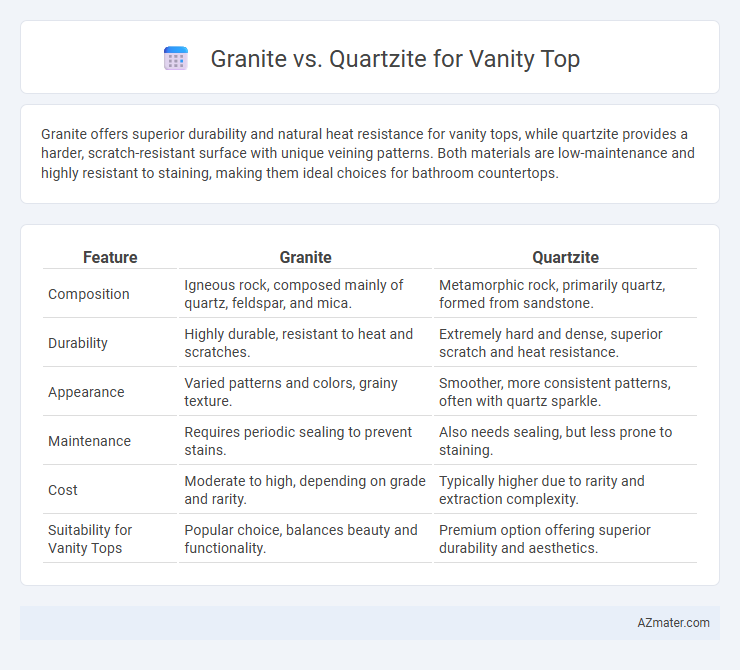Granite offers superior durability and natural heat resistance for vanity tops, while quartzite provides a harder, scratch-resistant surface with unique veining patterns. Both materials are low-maintenance and highly resistant to staining, making them ideal choices for bathroom countertops.
Table of Comparison
| Feature | Granite | Quartzite |
|---|---|---|
| Composition | Igneous rock, composed mainly of quartz, feldspar, and mica. | Metamorphic rock, primarily quartz, formed from sandstone. |
| Durability | Highly durable, resistant to heat and scratches. | Extremely hard and dense, superior scratch and heat resistance. |
| Appearance | Varied patterns and colors, grainy texture. | Smoother, more consistent patterns, often with quartz sparkle. |
| Maintenance | Requires periodic sealing to prevent stains. | Also needs sealing, but less prone to staining. |
| Cost | Moderate to high, depending on grade and rarity. | Typically higher due to rarity and extraction complexity. |
| Suitability for Vanity Tops | Popular choice, balances beauty and functionality. | Premium option offering superior durability and aesthetics. |
Introduction to Granite and Quartzite Vanity Tops
Granite vanity tops are natural stone surfaces known for their durability, resistance to scratches, and wide range of unique color patterns formed by mineral deposits. Quartzite vanity tops, often mistaken for quartz but naturally metamorphosed sandstone, offer exceptional hardness and a smooth, glassy finish that resists heat and etching better than many other stones. Both granite and quartzite provide elegant, long-lasting options for bathroom vanity tops, combining aesthetic appeal with functional performance.
Material Composition: Granite vs Quartzite
Granite is an igneous rock composed mainly of quartz, feldspar, and mica, offering durability and resistance to heat and scratches for vanity tops. Quartzite, on the other hand, is a metamorphic rock that originates from sandstone, primarily consisting of quartz grains fused under heat and pressure, resulting in a harder and denser surface. The high quartz content in quartzite makes it more resistant to etching and staining compared to granite, making it a popular choice for bathroom vanity tops.
Aesthetic Differences Between Granite and Quartzite
Granite vanity tops showcase a wide range of colors and bold, speckled patterns caused by the mineral composition, offering a dynamic and natural aesthetic. Quartzite, formed from sandstone metamorphosis, features softer, more consistent veining and smoother color transitions, providing a refined and elegant look. The choice between granite and quartzite impacts the bathroom ambiance, with granite delivering vibrant, varied visuals and quartzite presenting a subtle, sophisticated appearance.
Durability and Strength Comparison
Granite exhibits exceptional durability and resistance to scratches, heat, and stains, making it a popular choice for vanity tops. Quartzite, formed from sandstone, often surpasses granite in hardness, offering superior scratch resistance and longevity in high-traffic bathroom environments. Both materials require sealing but quartzite generally provides enhanced strength and reduced porosity, ensuring greater resilience against moisture and wear over time.
Resistance to Stains and Chemicals
Granite offers excellent resistance to stains and most household chemicals due to its dense, natural composition, making it a durable choice for vanity tops. Quartzite, while also highly resistant to stains, tends to be more vulnerable to strong acidic substances which can etch its surface over time. Both materials require proper sealing to maintain their resistance, but granite generally provides superior chemical resistance for long-term vanity top use.
Maintenance Requirements for Each Material
Granite vanity tops require periodic sealing every 1-2 years to maintain their stain resistance and prevent moisture infiltration, while quartzite demands similar sealing but often benefits from more frequent applications due to its natural porosity. Both materials benefit from daily cleaning with neutral pH cleaners to avoid surface damage, but granite can better withstand acidic substances compared to quartzite, which is more prone to etching. Proper maintenance ensures longevity and preserves the aesthetic appeal of both granite and quartzite vanity tops in bathroom environments.
Cost Comparison: Granite vs Quartzite Vanity Tops
Granite vanity tops generally cost between $50 to $100 per square foot, making them a more budget-friendly option compared to quartzite, which ranges from $70 to $120 per square foot. Installation and maintenance expenses for granite remain lower due to its widespread availability and easier workability. Quartzite, valued for its durability and unique appearance, often commands higher prices reflecting its natural hardness and rarity.
Installation Considerations
Installation of granite vanity tops requires precise sealing to prevent moisture penetration, as granite is naturally porous. Quartzite, being denser and harder, demands specialized cutting tools and expert handling to avoid chipping during installation. Both materials necessitate professional fabrication and precise templating to ensure a perfect fit and long-lasting durability in bathroom settings.
Environmental Impact and Sustainability
Granite vanity tops are naturally quarried stones requiring less processing, resulting in a lower carbon footprint compared to quartzite, which undergoes extensive mining and fabrication. Granite's durability and recyclability contribute to its sustainability, while quartzite, though equally resilient, often involves energy-intensive treatments that increase environmental impact. Choosing locally sourced granite can further reduce transportation emissions, making it a more eco-friendly option for vanity surfaces.
Which is Best for Your Vanity Top: Granite or Quartzite?
Granite offers exceptional durability and a wide range of colors, making it a popular choice for vanity tops that withstand daily use and resist scratches and heat. Quartzite, a natural metamorphic stone, provides superior hardness and a unique, marble-like appearance, ideal for homeowners seeking both elegance and longevity. For your vanity top, choose granite for cost-effective toughness and quartzite if you prioritize a luxurious aesthetic combined with strong resistance to staining and etching.

Infographic: Granite vs Quartzite for Vanity Top
 azmater.com
azmater.com